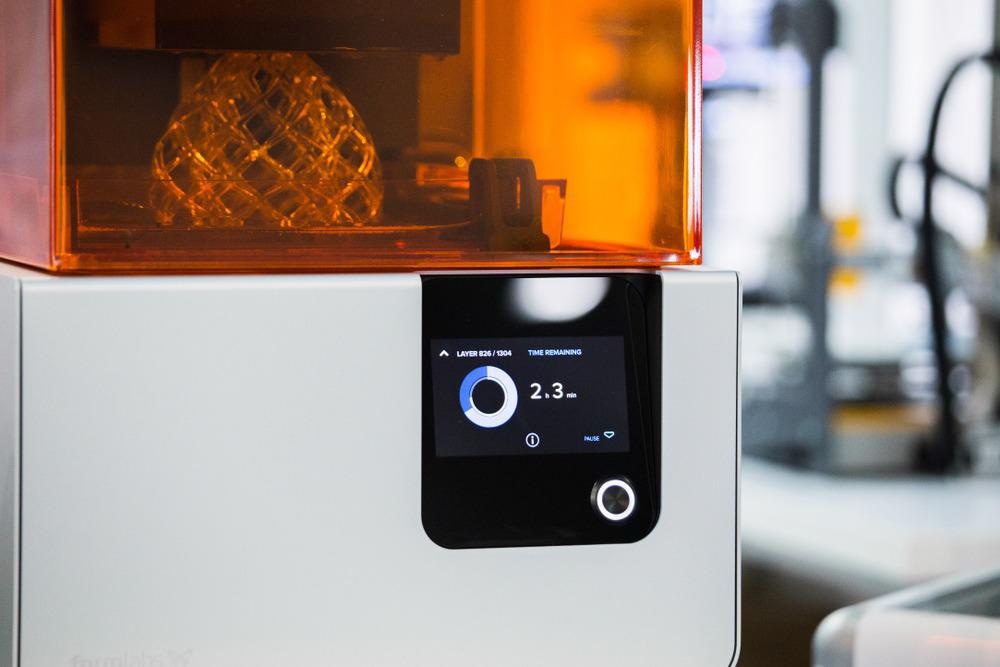In a recent study published in the journal Additive Manufacturing, researchers developed new wired grid polarizers for monochrome liquid crystal device (LCD) used for the patterning of ultraviolet light (UV) in vat polymerization stereolithography.

Study: Use of Wire Grid Polarizers with Liquid Crystal Display for Large-Volume Stereolithography. Image Credit: Scharfsinn/Shutterstock.com
The transmission efficiency of the prepared reflection-based wire grid polarizers was higher (44%) than that of absorption-type film polarizers (25%). Increased transmission efficiency and lower wavelength light resulted in a higher intensity of UV light for polymer curing, a larger depth of penetration, a larger curing surface at a time, and a shorter curing time.
UV Light LCD for Stereolithographic Vat Polymerization
In vat polymerization stereolithography, a photocurable polymer is cured point by point and layer by layer in a large container using visible light or UV light for 3D prototyping. The source of light can be a laser for spot curing or based on the projection of light for larger area curing.
Projection micro stereolithography (PμSL) uses a spatial modulator, such as a liquid crystal device (LCD), liquid crystal on silicon (LCoS), or digital micromirror device (DMD), to project light over the entire resin surface at a time; this makes prototyping way faster than laser-based curing.
However, there are certain limitations with PμSL; for example, projection from a small size spatial modulator chip requires high magnification, which reduces the intensity of light for larger surface area, especially for less reactive silicone resins.
Additionally, DMD and LCoS chips have a maximum intensity limitation. In the case of LCD-based masked stereolithography (MSLA), two orthogonal film polarizers are used to produce polarized light. The electrical fields generated in these films absorb light that is aligned with them and pass the remaining polar lights that are perpendicular to the electrical field. However, this absorption mechanism reduces effective light intensity for photocuring.
As a solution, the use of wired grids with a pitch length of one-third of the wavelength of light can be used for a similar purpose.
More from AZoM: How Can AI Overcome 3D Printing Defects?
The wires absorb light parallel to them but transmit light perpendicularly to them. The only difference is that they scatter light instead of absorbing them. This results in higher transmission efficiency of wire grid polarizers than film polarizers for LCD-based PμSL. Moreover, film polarizers can withstand a light intensity damage threshold up to 1000 mW/cm2, whereas metal wire grids can withstand much higher than that.
About the Study
In this study, researchers analyzed lower wavelength color and monochrome (UV) LCDs using stretched polyvinyl alcohol (PVA) film and wire grid (NILT) polarizers. PR48 and photocurable silicone resin were cured using a 405 nm LED array of 15 mW/cm2 and a 385 nm LED array of 85 mW/cm2 intensity. The screen size of monochrome UV LCD was 13.3” with a pixel pitch of 76.5 μm.
Further, the modulation transfer function (MTF) was determined from maximum and minimum intensities obtained from alternating fully black and fully white screens. A spectrometer was used to measure the transmittance and reflectance of the wire grid polarizer. K-type surface mount thermocouples were used to measure the temperature of the LCD screen and both types of polarizers.
Observations
The transmittance efficiency of UV light passing through the stretched PVA film polarizer decreased sharply at shorter wavelengths, whereas the wire grid polarizer transmitted a higher percentage of light for each wavelength. For wavelengths 365, 385, 405, and 450 nm, the film polarizer had a transmission efficiency of 0.0, 1.1, 22.9, and 34.8, respectively, whereas for the wire grid polarizer it was 34.4, 39.3, 39.1, and 42.5, respectively.
It was evident that the transmission performance difference between film and wire grid polarizers was much more significant for light below 400 nm wavelength. The obtained transmittance results for 405 nm light matched the expected transmission values for wire grid and film polarizers of 44% and 25%, respectively. Moreover, the contrast ratio of transmitted polarized light through a white screen compared to a black screen decreased for wire grid film polarizers relative to film polarizers.
Conclusions
In summary, researchers of this study compared the transmission performance of stretched PVA film polarizer with wire grid polarizer for PR48 and photocurable silicone resin in monochrome UV light LCD for vat polymerization stereolithography.
The wired grid polarizer demonstrated higher transmission efficiency, higher output intensity, and a higher damage threshold than that of stretched PVA film polarizers owing to scattering of light than absorption of light mechanism. Moreover, the contrast ratio between the white screen and the black screen was less for wire grid polarizers. Hence, wire grid polarizers are a promising component of UV LCD-based vat polymerization stereolithography.
Disclaimer: The views expressed here are those of the author expressed in their private capacity and do not necessarily represent the views of AZoM.com Limited T/A AZoNetwork the owner and operator of this website. This disclaimer forms part of the Terms and conditions of use of this website.
Source:
Rodriguez, N., Song, H., Chen, M., Oakdale, J., Duoss, E., Seepersad, C., Crawford, R., Use of Wire Grid Polarizers with Liquid Crystal Display for Large-Volume Stereolithography, Additive Manufacturing, 2022, 102641, ISSN 2214-8604, https://www.sciencedirect.com/science/article/pii/S2214860422000471?via%3Dihub